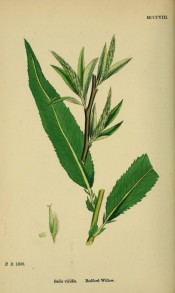Salix fragilis L. var. russelliana
A large tree with wide-spreading branches, rugged bark and brittle twigs. the slender catkins appear with the leaves in spring. To 25m. It commonly grows with Salix alba L. and hybrids between the two occur naturally. Intermediate between the parents they are called Salix x rubens Hort. [RHSD, Hortus, Hilliers’].
Horticultural & Botanical History
‘This tree [Salix fragilis] is tall and bushy-headed, growing from eighty to ninety feet high. The branches are round and very smooth, and “so brittle at the base in spring, that with the slightest blow they start from the trunk. Hence the name of ” crack willow,” though, according to Sir J. E. Smith, this is more or less the case with other willows, both native and exotic. It is also known as the “red wood willow,” or ” stag’s head osier.” The heart wood is of a deep red colour, very tough, and not as soft as that of most trees of the genus. It is very durable, both under water and when exposed to the air, and makes good fences, posts, and handles for implements of husbandry. When seasoned well it may be used in building houses, for planks, &c., and will last well. Many medical properties were formerly attributed to this tree, which is generally distinguished, par excellence, as “the willow.” The roots of the tree are used in Sweden to boil with eggs to make them of a purple colour at Easter time. Gilpin writes, “The withy, or Salix fragilis, is of little value in landscape, and yet there is something beautiful in its silver catkins, which open, as the year advances, into elegant hanging tufts, and when the tree is large and in full bloom, make a beautiful variety among the early productions of the spring.” The bark of S. fragilis and its varieties contains a large quantity of tannin, and is probably little inferior to that of the oak. The bark sold by druggists for medical purposes is collected indiscriminately from this and other species.’ [English Botany vol.8, p.207, pl.MCCCVI/1868]. [English Botany vol.8, p.207/1868]. A number of varieties are described and figured, including Salix viridis as a separate species. Salix Russelliana Sm. is given as a synonym and this is the figure used as illustration [English Botany vol.8, pl.MCCCXIII/1868]. Salix fragilis and its many forms was a very important tree in the rural economy of many parts of England and Wales, being the principal timber used for fencing and many other uses. Pollarded Withies were once a common sight.
‘[Salix Russelliana is] More handsome than the last [Salix fragilis] in its mode of growth, as well as altogether of a lighter or brighter hue. The branches are long, straight and slender, not angular in their insertion like S. fragilis, and the trees, when stripped of their leaves, may always be distinguished by these marks. They are polished, very tough, flexible, round and smooth. […] The foregoing distinctions will always mark this Willow as a separate species from the fragilis, which is the more important on account of the wide difference in their qualities and value. S. Russelliana, first brought into notice by the late Duke of Bedford, who engaged an able chemist, Mr. Biggin, to make experiments upon it, was found to contain, in its bark, more of the tanning principle, than any other tree of this country, except the Oak. Hence this bark, taken for S.fragilis, has been found useful, as a substitute for the Cinchona, in agues; and if it has occasionally disappointed some medical practitioners, they probably chanced, in such cases, to give the real fragilis. Tanners have sometimes been, in like manner, deceived, and they will find it worth their while to observe the character of the tree, in future, before they purchase its bark. On the other hand, when the tree in question was first recommended for cultivation, by the name of the Leicestershire, or Dishley, Willow, it was regarded with scorn, as ‘‘only the Crack WilIow,” a sort notoriously useless. This ignorance and prejudice are now removed, and S. Russelliana is found the most profitable for cultivation of any species of the genus, for the value of its timber as well as bark, the rapidity of its growth, and the handsome aspect of the tree.’ [The English Flora vol.4, p.186/1828].
History at Camden Park
Listed only in the 1857 catalogue [T.920/1857]. Probably introduced primarily for its medicinal and industrial value.
Notes
Salix fragilis L. is a weed in parts of NSW. [Beadle]. The habit of most willows of shedding branches which then very readily root has made it an important weed in many parts of Australia, particularly along creeks and rivers, its favoured habitat.
Published Mar 26, 2010 - 05:07 PM | Last updated Mar 29, 2010 - 03:07 PM
| Family | Salicaceae |
|---|---|
| Category | |
| Region of origin | Britain |
| Synonyms |
|
| Common Name | Withy, Crack willow, many other local names. Salix russelliana was usually known as Bedford willow |
| Name in the Camden Park Record |
Salix Russelliana |
| Confidence level | high |
